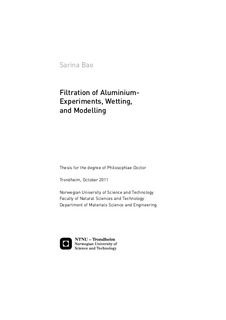| dc.contributor.author | Bao, Sarina | nb_NO |
| dc.date.accessioned | 2014-12-19T13:25:39Z | |
| dc.date.available | 2014-12-19T13:25:39Z | |
| dc.date.created | 2012-01-12 | nb_NO |
| dc.date.issued | 2011 | nb_NO |
| dc.identifier | 477013 | nb_NO |
| dc.identifier.uri | http://hdl.handle.net/11250/248882 | |
| dc.description.abstract | The present work deals with the inclusion removal mechanism in aluminium filtration and the use of alternative filter materials. Four routes are investigated.
First, an overview of previous research on filtration knowledge is summarized. The filtration mechanism comprises two parts: transport of inclusions to the filter wall and attachment of inclusions on the wall. We have mainly investigated collision by interception and the wetting (surface tension) of inclusion-Al and Al-filter in this work.
Second, the wetting behaviour of inclusion-Al and Al-filter is measured in the laboratory.
In filtration it is important that particles to be removed contact, or come close to the filter walls. Therefore the metal carrying the inclusions must come into close contact,i.e. wet the filter material. A systematic and comprehensive investigation of the wetting behaviour in the molten aluminium-filter system is presented. In aluminium filtration,alumina is the most common filter material, even though alumina is not wetted by aluminium. Therefore we have investigated the use of alternative filter materials withimproved wetting. In the laboratory, SiC and graphite demonstrate good wetting bymolten aluminium. Problems with these materials exist, as SiC is easily oxidized to SiO2 and both react with aluminium to give Al4C3. However, SiO2 and SiC react slowly with aluminium, but this does not seem to influence the wetting.
The wettability of the inclusion-Al may play a key role in aluminium filtration. Particlesto be removed should ideally have poor wetting with aluminium and filter should hasgood wetting with aluminium. A challenge is that SiC and Al4C3 inclusions show betterwetting with aluminium than alumina.
Third, plant scale filtration experiments were carried out with Al2O3 and SiC industrial filters. Metal composition was not changed by the industrial filters. Improved wetting of aluminium on filter materials is an advantage in getting molten metal to infiltrate filtersand thus to improve the filtration efficiency. A SiC filter gives better filtration efficiency. Filtration efficiency increases with particle size. SiC reacts with aluminium so slowly that no carbide inclusions were produced in the industrial SiC filter with approximately 60% of SiC. SiC filters have better wetting than Al2O3 filters with aluminium. Thus SiC could be a good alternative filter material.
Fourth, a theoretical model is developed regarding the interceptional and gravitational collision considering the filter as a collection of branches (cylinders). A filtration efficiency equation is derived based on particle diameter, branch diameter, porosity,filter thickness, filter specific surface area, and Reynolds number.
The filtration efficiency decreases with the flow rate until it reaches a minimum, and then increases. Gravitational collision must be taken into account at the lower flowrates. The greater the velocity the less time particles have to settle. Thus gravitationalcollision efficiency decays with increasing flow rate. The interceptional collision efficiency increases with the velocity since then more liquid and particles come into contact with the collector. The interceptional collision efficiency that dominates at high velocities is the main topic of the model | nb_NO |
| dc.language | eng | nb_NO |
| dc.publisher | Norges teknisk-naturvitenskapelige universitet, Fakultet for naturvitenskap og teknologi, Institutt for materialteknologi | nb_NO |
| dc.relation.ispartofseries | Doktoravhandlinger ved NTNU, 1503-8181; 2011: | nb_NO |
| dc.title | Filtration of Aluminium-Experiments, Wetting,and Modelling | nb_NO |
| dc.type | Doctoral thesis | nb_NO |
| dc.contributor.department | Norges teknisk-naturvitenskapelige universitet, Fakultet for naturvitenskap og teknologi, Institutt for materialteknologi | nb_NO |
| dc.description.degree | PhD i materialteknologi | nb_NO |
| dc.description.degree | PhD in Materials Technology | en_GB |
